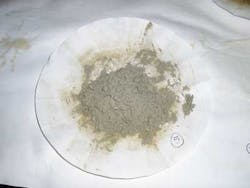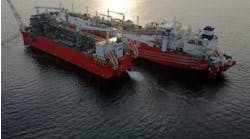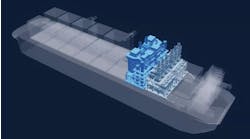Colin Sherwood
David Cairns
Kieran Morton
Stork Technical Services
As reservoirs mature there is an almost inevitable increase in water cut and associated sand production. Recompletion may be preferable to drilling a new well, but even so the completion is still within the region of the oil/water interface and, in time, water cut and sand production return to the produced fluids.
Sand production increases as older wells reduce their yield and in new wells where reservoir properties dictate the need for sand screens and proppant in the well completion. These issues can lead to carry over of solids from the reservoir to the wellbore and on into the process facilities which can cause flow assurance problems which impact integrity, transportation, cleaning, and disposal.
Stork Technical Services has developed a sand management solution that uses integrity and particle monitoring to assist with developing and controlling maximum allowable sand production rates in combination with proactive online sand removal and cleaning. This can change the profile of shutdown and outage campaigns, enabling operators to achieve more uptime from mature assets and fields while reducing costs.
Sand presence issue
The presence of sand in production vessels not only reduces capacity but also affects separation performance, leading to deterioration in the quality of produced water and an increase in water carryover in the oil phase. If uncontrolled it can result in the need to take a separator offline for a manual clean out, which exposes specialist cleaning teams to process hazards and may result in downstream equipment damage.
Once sand is extracted, operators face storage issues if they cannot dispose of the material overboard due to the oil-on-sand discharge rule limitations. Lack of understanding of compliance with new directives has led to unnecessary transportation and cost, especially when dealing with hazardous material such as NORM (naturally occurring radioactive material) waste.
Monitoring methods
One recommended sand management solution monitors the rate and volume of sand production. By analyzing this information, in conjunction with an understanding of the well control philosophy of the asset, can lead to better control of the wells in regard to sand production and corrosion/erosion risks. This allows for the planned use of an online desanding system rather than as a later reaction to separator performance issues caused by sand accumulation. Reactive sand management techniques require an unplanned and costly shutdown period of 10 to 14 days, which impacts the asset's production schedule.
Non-intrusive acoustic sand detectors provide instantaneous indication of sand in produced fluids by detecting the noise made by sand grains (or other particulates) as they hit the pipe wall at a bend point. Non-intrusive sand detectors are mounted on the outside of the production pipework, typically immediately downstream of an elbow or a bend. The noise generated by the impacting sand grains produces a high frequency (ultrasonic) pulse that is transmitted through the pipe wall and is detected by an acoustic sensor (transducer) attached to the pipe wall. The acoustic sensor converts this ultrasonic pulse into an electrical signal that is transmitted to a dedicated computer which quantifies the sand being produced. However, the presence of solids does not provide an indication of the potential erosional integrity issues.
Intrusive particle probes provide a long-term indicator of erosional behavior. The operating principle of the intrusive particle monitor is similar to that of an electrical resistance corrosion probe. Both types of detector use elements exposed to a flow. However, particle monitors differ from corrosion probes in that the sensing elements are resistant to corrosion. Any material loss from the sensing element causes a reduction in the cross-sectional area and is detected as an increase in the electrical resistance of current flow through that element.
To compensate for flow-related effects such as temperature, which also influence electrical resistance, an element protected from erosion damage by being placed on the downstream side of the probe also is included. Particle monitors detect the presence of sand by a change in electrical resistance of the eroded element and require a definitive time period of around four to six hours before sand production can be declared.
While the presence and erosional behavior of solids provides data for analysis, it does not provide direct indication of pipe erosion. Incorporating Ultrasonic Thickness (UT) Mat Technology to the monitoring solution provides actual wall thickness measurements to correlate with monitored erosion rates. This allows for more accurate and more frequent UT measurements compared to standard handheld UT wall thickness measures.
Sand monitoring equipment can be installed as stand-alone. Data can be downloaded through handheld interrogation units, fully integrated into the installation DCS (distributed control system), or connected to remote access networked systems. The integrated and remote access methods allow for onshore data review and quick diagnosis of potential sanding events.
Planning proactive sand removal, cleaning
Once sand has been identified and quantified, a third-generation online desanding system can be deployed to remove sand from online production vessels and thereby negate the need to shutdown. While many separator vessels have inbuilt desanding, they are prone to blocking, expensive to retrofit, and require the vessel to be taken off-line in the event of failure.
The desander incorporates a wash system to quickly and effectively treat produced solids for discharge overboard. The system cleans the sand removed from the production process to less than 1% oil-on-sand content, within guidelines of the Department of Energy and Climate Change in the UK and Environmental Protection Agency in the United States, so that it can be disposed overboard. The desander has been subjected to an independently facilitated design HAZOP and numerous client required HAZOPs without any requirement for design change.
The mobility of the system allows sand production problems to be dealt with cost effectively, as there is no need to design or manufacture special hardware or to shutdown the process for installation. The package connects via the existing separator drain valves, with minimal effect on the existing infrastructure. Thermographic imaging monitors sand levels prior to, during, and after desanding. With the accumulated solids removed, separator performance efficiency is restored and throughput can be increased. The extracted oil is returned to the process via the platform's hazardous drainage system.
The desander enables sand to be removed prior to a shutdown and minimizes the risk to specialist cleaning operators, and allows a smaller team, with high technical expertise, to be deployed during the actual shutdown. This alters the resource profile required and impacts positively the overall shutdown and outage planning.
Online desanding case study
The success of the online desanding system was demonstrated in a recent project for a major operator offshore Angola. The scope of the project required the removal of an estimated 200 metric ton (220 tons) of sand from six "live" production vessels to interim containment skips, ready for washing and subsequent discharge.
A project team of eight desanding specialists removed approximately 627 metric ton (691 tons) of sand from the separators over three five-week campaigns without the need for a shutdown. Production was maintained at rates of approximately 140,000 b/d during desanding and sand washing, and the project was completed with no harm to people or the environment.
All of the sand was washed to below 1% oil on sand, in line with Angolan operating requirements, with an average of 0.4% oil on sand. The overboard discharge standards were established with the Angolan authorities and levels of oil-on-sand met those requirements.
Offshore Articles Archives
View Oil and Gas Articles on PennEnergy.com






